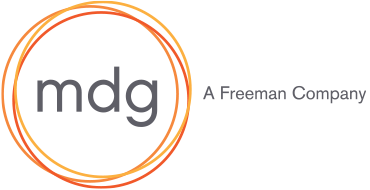
From ChatGPT and DALL-E to Photoshop integrations, generative AI is everywhere — and a hot topic of discussion across marketing departments. Here’s how eight mdg specialists are thinking about these tools and applying them to their work. (Spoiler alert: there’s no replacement for human intelligence and ironclad, company-wide usage policies are essential).
Kacia Reilly, group director, creative
In the design world, generative AI can help us test-drive concepts and decide where to invest our resources. These tools create visuals based on our ideas that are useful in determining whether an approach to a concept is viable. That frees us up to explore more, because we don’t have to spend time — and budget — creating complicated composite Photoshop files just to find out that something doesn’t work.
Anjia Nicolaidis, group director, international strategy
We’ve always known that localization is essential for hitting attendee acquisition targets. With that in mind, we’ve been experimenting with generative AI primarily in a translation capacity. The results are certainly impressive, but it’s still essential to have that human review step and a prompt that reflects the nuances of a specific language. I’m looking forward to seeing how these solutions evolve and tapping into their potential to streamline different international marketing tasks, like market research.
Clinton Hall, web developer
I view generative AI as something that’s going to elevate me, and that’s exciting. Already, it’s been a useful problem-solver when it comes to debugging and an excellent educator — I’m learning functions and new coding languages faster because it explains things in such logical, simple formats. I look forward to potentially integrating AI into our production builds and stacks down the line, to continue increasing productivity.
Sara Fellows, director of social media
I think there’s a lot of opportunity for generative AI to support and expedite social media marketing tactics. Right now, these tools are primarily brainstorming assistants that can help get my creative wheels turning. But because they can quickly aggregate a good amount of information and make it digestible, I can see them being useful with everything from reporting to research and contract management for influencer campaigns in the near future.
Shereé Whiteley, copy director
For me, it’s all about opening up new creative pathways. Generative AI is useful when brainstorming — it can suggest different words, headline structures or industry terms, and that sends my mind in different directions. I see these tools as an asset instead of a threat. While they can generate coherent content, they lack the ability to understand an audience’s motivations and pain points in a human way, can’t ensure accuracy, aren’t familiar with the nuances of a specific brand voice and don’t have the capacity to produce truly original work — but they can help professionals with those skills expand their own creativity.
Caitlin Fox, vice president
AI is a useful tool for uncovering strategic insights. By asking questions like, ‘What are 10 commonly held beliefs about [insert industry]?’ and ‘What are 10 trends that are changing the landscape of [insert industry]?’ we can gain a better understanding of that industry’s general landscape and its public perception. This enables us to either align with or challenge those findings in our marketing approach. While it’s important to note that AI may not have access to the most recent data, leveraging these tools helps us quickly grasp the dynamics of diverse industries and think creatively when developing campaign strategies.
Christine Johnson, director of content
We’re starting to incorporate AI into the development of audience personas, which makes the whole process more efficient and improves the final product. We use generative tools to supplement our existing audience research, transcribe interview recordings and even produce a unique and evocative image of the person we’re hoping to attract with our campaign. All of that helps us get a clearer picture of who we’re targeting, which is essential for achieving our (and our clients’) goals.
Mike Engard, web developer
As a software developer, LLM tools (commonly referred to as “AI”) have already saved me hours of time, much as they have for my colleagues in other disciplines: by shortening the distance between intention and execution. Once I know what I want a piece of code to do, I’m only seconds away from having a live, working example. Sometimes, that means my work is already done. Other times, being able to see the most general or predictable path forward offers a valuable opportunity to take the road less traveled — which is arguably just as valuable as getting a right answer on the first try.
A version of this article originally appeared in PCMA Convene.


